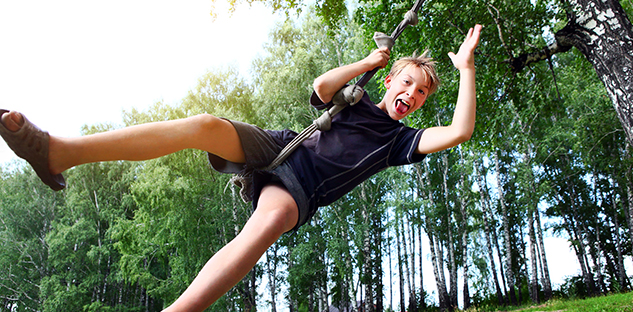
Natural Interventions Across MTSS Tiers
By Sage W. Rian, Ph.D. | January 2022

 Nature and Health
Nature and HealthThink back to the last time you spent the day outside on a hike, a bike ride, a long walk or taking the time to sit somewhere and soak in the scenery. How did you feel afterwards? What impact did spending time outside have on your mind and body? If you’re anything like me, getting out in nature can make you calmer, happier, less stressed and more grounded. Regardless of the specific activity you choose to do or place you decide to go, research shows that spending time in nature reduces stress, depression, anxiety, aggression, ADHD symptoms, obesity and mortality. It improves happiness, prosocial behavior, connectedness, child development (cognitive and motor), immune function, sleep and other domains of general health.
Nature in the Schools
Many academic benefits are also associated with time spent in nature, including improved cognitive abilities such as concentration and critical thinking, self-discipline, engagement, enthusiasm for the learning process and overall academic achievement. This may be because nature significantly affects attention capabilities by reducing inattentiveness and helps students regulate their emotions, which improves their overall classroom and learning experience. Getting outside even for just five minutes can have a powerful, positive impact on our students’ brains and bodies. Nature-based learning in the elementary schools is becoming more popular for science lessons but has yet to be meaningfully incorporated into non-STEM subject lessons, which is where the school counselor comes in. You can reach all students in the school through interventions across tiers of the multitiered system of supports (MTSS) framework.
Interventions at Every Tier
No matter what you are doing, bringing students outside requires extra considerations. One of the biggest differences is around confidentiality; you will need to be mindful of who might see or hear you outside and whether or not this will be appropriate for the student and the intervention; you must also ensure that the student gives informed consent. Consider your own comfort level with being outdoors, in addition to the student’s comfort and desires; this should also include a discussion around any allergies, fears or concerns. Not all students feel comfortable outside, and there is an important intersection with students who are Black, Indigenous or people of color (BIPOC) and recent events where BIPOC people have been harmed while trying to enjoy nature, such as through bird watching and jogging.
After you and your student(s) have determined that you want to move outside, you will need to decide on an appropriate intervention. At Tier 1, core instruction and school-wide programming, one of the main ways you can reach all of your students is through classroom instruction. When the weather is appropriate, you can conduct your lesson outdoors – I like to use the school soccer field. If bringing the students outside is not an option, you can bring natural materials, such as leaves, rocks and sand, indoors to supplement lessons. ASCA has also put out a book full of nature-based elementary-level classroom lessons as part of the School Counselor Resource Series, titled “Teaching Mindsets & Behaviors Through Nature,” by Dr. Barbara Flom. Another Tier 1 possibility is a school garden; you can determine responsibilities based on grade and what is developmentally appropriate for the students. I recommend planting things that will grow at a variety of paces, so students stay interested and can see the fruits of their labor. Growing vegetables for students to take home is also a great way of sharing healthy resources with the community and engaging families.
At Tier 2, supplemental support, you are looking at interventions like group counseling. Depending on the students and the topic of the group, you may be able to conduct sessions outside, either seated or walking. If you have students with behavioral issues during recess, you can also conduct a structured recess program in which you first teach students the skills they need, and then bring them outside for a mock recess. As issues arise, you can work with them in real time to help students work through the issues they are facing and reinforce the skills you have taught. Time outside is also a strong reinforcer that can be used for behavior contracts, or you can do your check-ins and check-outs somewhere outside.
At Tier 3, intensive support, the main intervention is individual counseling, or ecocounseling (also called ecotherapy). Ecocounseling uses a broad assortment of practices, but all are conducted using natural resources and/or outdoors to promote interconnectedness between humans and nature. This can look like taking your counseling sessions outdoors and using the playground or other spaces for play therapy. Establishing physical boundaries (such as fences, bushes, etc.) is important for safety and privacy when outside with students, as is following other safety rules, such as handling garden tools. Therefore, students who struggle with boundaries may not do well with outdoor counseling. However, you can also bring in natural materials to use in lieu of manufactured toys, such as rocks, sticks, leaves, flowers, shells, and sand or dirt. These materials are also great for art-based interventions, such as painting on rocks.
However you incorporate nature into your school counseling curriculum and interventions, remember to have fun with it and keep checking in with your students to make sure they are enjoying it, too.
Sage W. Rian, Ph.D., NCC, is a school counselor educator for the University of Denver, working remotely from Truckee, California. Please contact the author for complete references at Sage.Rian@du.edu.